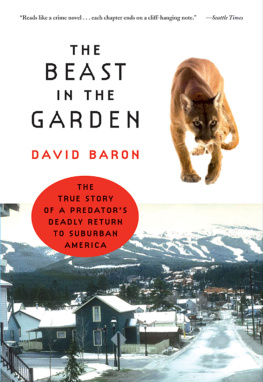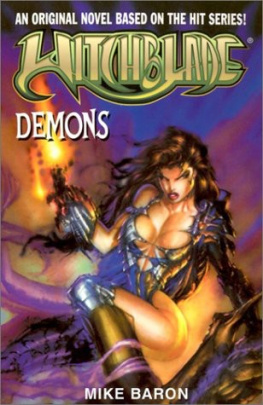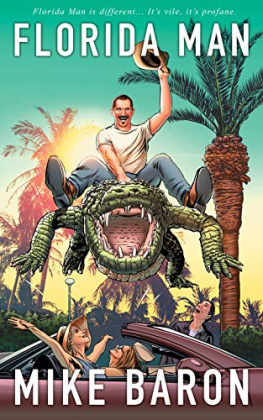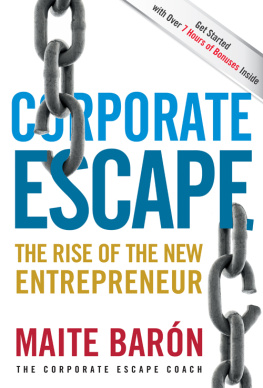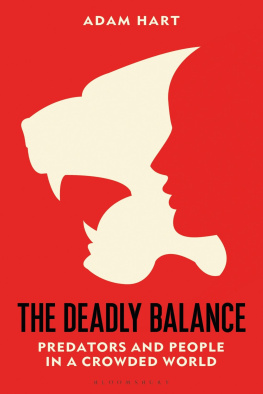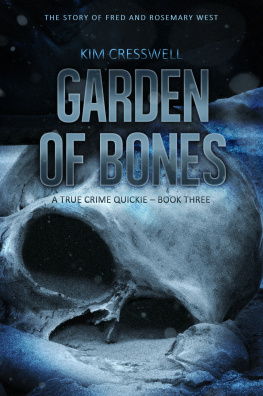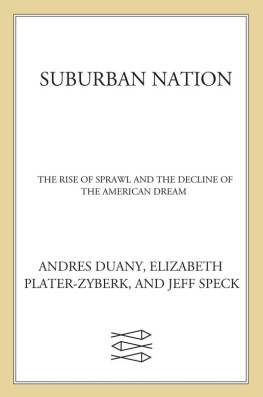More praise for The Beast in the Garden
David Barons The Beast in the Garden betrays some of the most enduring myths of the American West and the American environmental movement. Its a gripping tale of human navet, misguided intentions, and conventional wisdom gone awry. It reads like a novel but its all true. And its happening right on the edge of town.
Howard Berkes, National Public Radio
Raises powerful questions, and reminds even those of us who live in cities that we share our space with animals we see, and many that we do not.
MSNBC
Baron explores what it means that lions are repopulating developed areaswith pollution declining, wilderness acreage expanding, and lion hunting forbidden, there will be ever-more [cougars] in American and Canadian exurban areas.
Gregg Easterbrook, The New Republic Online
The Beast in the Garden is told like a whodunit, in reverse. From the beginning, we know the identity of the killer: a 100-pound adult male mountain lion spotted near the eviscerated corpse of an 18-year-old jogger in the Rocky Mountain foothills west of Denver in 1991. Baron sets out to uncover how and why an animal known to biologists to be nocturnal and elusive, likely to flee if and when it is seen, came to pounce upon a high school student out for a run during fifth period, just after a lunch of pepperoni pizza at the local 7-Eleven.
Salon
David Baron has done an extraordinary job of scoping out the personalities on each side of the issue: those officials who didnt see any reason to act, and those on the outskirts of Boulder who were seeing their pets disappear while lions sunned themselves in backyards and pressed their noses to terrace doors.
National Geographic Adventure
A chilling, cautionary tale. Its also a terrific read.
Pittsburgh Post-Gazette
A real page-turner. [Baron] does a public service by presenting the harsh reality of what happens when wild creatures become habituated to humans.
Audubon
One of the very best accounts of the conflict between doing what is thought of as being environmentally correct versus using common sense.
Plattsburgh Press-Republican
Baronperceptively dissect[s] both sides of the impassioned debate these terrifying confrontations engender, revealing how nave and unrealistic the live-and-let-live approach can be, and how easy it is to take the kill-the-miserable-beasts response to unreasonable extremes.
Booklist
The Beast in the Garden brings out the deep contradictions in our attitudes toward what we loosely call Nature. In a time when our debates about the environment so often come down to strident, simplistic claims on all sides, the intelligent complexity of Barons book is refreshing and necessary. Hes packed this book with honest emotion and good sense, and hes managed to portray all the animals involved, human and otherwise, with compassion. This is an extraordinary achievement.
Gordon Grice, author of The Red Hourglass: Lives of the Predators
Its about environmentalism either gone terribly wrong or brilliantly correct, depending on your perspective. The Beast in the Garden leaves it up to you to decide.
Providence Journal
A compelling parable of man and animal, of the Old West and the New West, of wildlife that is no longer wild. [Baron] shows how mountain lions, once enemies to be exterminated, have become revered symbols of a wilderness that no longer truly exists.
High Country News
Written with the dramatic flourish of a thriller, Barons fascinating book is a cautionary tale of what happens when we destroy animal habitats: eventually, we are forced to co-exist, and, while animals may struggle to adapt to our environment, we are totally unprepared for life in close proximity to them.
The Ecologist
This book should be read by field biologists and administrators of natural resource agencies and by activists who promote the return of large carnivores in their native ranges. Restoring large carnivores is not as simple as just wanting them back. Baron reminds us of this in exquisite detail.
Conservation Biology
Anyone who cares about large predators and their future survival should read this book.
Harley Shaw, wildlife biologist and author of Soul among Lions: The Cougar as Peaceful Adversary
Denver/Boulder bestseller
Los Angeles Times Book Prize finalist
Chosen by Library Journal as one of the best sci-tech books of 2003
THE BEAST IN THE GARDEN
A Modern Parable of Man and Nature
DAVID BARON
W. W. NORTON & COMPANY NEW YORK LONDON
Copyright 2004 by David Baron
All rights reserved
First published as a Norton 2005
Title page image Daniel J. Cox / Getty Images
Part I opener, Union Pacific Rail Road poster circa 1891, courtesy of Archives, University of Colorado at Boulder Libraries.
Part II opener, lion print at the corner of Ninth Street and Arapahoe Avenue, Boulder, January 1989, courtesy of Michael Sanders.
Part III opener, Animal Control Officer Clay Leeper and Boulder police with tranquilized lion on University Hill, August 24, 1990. Photo by Charlie Johnson, courtesy of Colorado Daily .
Visit the companion Web site at www.beastinthegarden.com.
For information about permission to reproduce selections from this book, write to Permissions, W. W. Norton & Company, Inc., 500 Fifth Avenue, New York, NY 10110
Maps on Frontmatter by Paul J. Pugliese. All other maps by John McAusland.
Library of Congress Cataloging-in-Publication Data
Baron, David, 1964
The beast in the garden: a modern parable of man and nature /
David Baron.1st ed.
p. cm.
Includes bibliographical references.
ISBN: 978-0-393-32634-5
1. PumaColoradoBoulder Region. 2. Human-animal relationshipsColoradoBoulder Region. I. Title.
QL737.C23B26524 2003
599.75'24'0978863dc22
2003016111
W. W. Norton & Company, Inc.
500 Fifth Avenue, New York, N.Y. 10110
www.wwnorton.com
W. W. Norton & Company Ltd.
Castle House, 75/76 Wells Street, London W1T 3QT
For Paul
And to every beast of the earth, and to every bird of the air, and to everything that creeps on the earth, everything that has the breath of life, I have given every green plant for food.
And it was so.
Genesis 1:30
CONTENTS
THE BEAST IN THE GARDEN
Maps

The Front Range: A north-south trending massif of the Colorado Rocky Mountains, historical habitat of Puma concolor , the mountain lion.

Prologue
DEATH IN THE ECOTONE
JANUARY 16, 1991
T he Colorado sun burned through a mantle of winter gloom, dappling the rocks, the trees, the snow with a warm glow, giving an air of spring to the January hillside. Ponderosa pines, their needles carpeting the ground, shimmered in the silvery light beside a town that owed its existence to gold. The forest lay open, trees interspersed with grasses and shrubs that could tolerate the heat and low moisture of the south-facing slope, vegetation that provided excellent cover for a creature in hiding.
The sounds of civilizationtrucks on the interstate, dogs in backyards, students at the high schoolcarried up the hill, where half a dozen men had gathered. Wearing boots, gaiters, and wool hats, the men assembled in a line along a ridge and trudged eastward in unison. Heads pivoted and necks craned as the search party scanned the terrain for clues: a piece of clothing, a candy wrapper, a footprint, anything that might help explain how a healthy, young athlete had vanished in the middle of an average Monday on the edge of a small Rocky Mountain city. The men looked behind trees, under bushes, beside rocks and fallen logs, but they found nothing.

